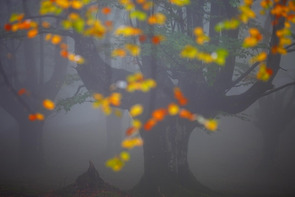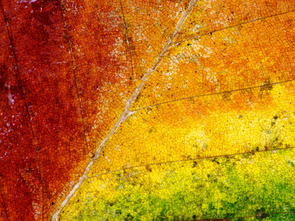Urtzi Vera - Spain

Urtzi Vera was born in Bilbao in 1975 and has been living in the town of Orozko for 25 years. He is an industrial engineer by profession.
As a child Urtzi Vera had a great passion for drawing and other forms of creative expression. His toys were pencils, chalks and clay. When he gave up his profession as an engineer, he took up the threads from his childhood and visited creative workshops in painting, drawing and clay modelling. This time, which he remembers as extremely rewarding, probably laid the foundations for his future work.
To Urtzi Vera, nature has always been a source of inspiration. In 2005 he took a point-and-shoot camera and went off into the Basque mountains - and this was the moment when his passion for photography took roots.
Today he spends most of his time in the region between the mountain of Gorbeia and the Cantabrian Sea. While enjoying a deep connection with the mountains and the ocean, forests and woodlands are his true love. This is where he feels most comfortable, this is where he takes the most pleasure from photography.
For many years he has been showing his images in group as well as solo exhibitions. Over the course of the years, his images were met with great consideration at numerous international competitions, such as Montphoto, Fotocam, Memorial María Luisa, Montier en Der, Asferico, Glanzlichter or the Golden Turtle Award.
His work is frequently published and he works with various agencies that market his images at home and abroad. Currently he is working on several photographic assignments.
www.urtzivera.blogspot.com.es
Project: The pollarded beech trees in the forest of Gorbeia
I was still a child when we moved to the village of Orozko in the Basque Country, and since my very first visit to the forest, the pollarded beech trees in Gorbeia forest have continued to capture my imagination. Their characteristic appearance derives from an old form of forest management: the trees were trimmed to increase the number of their side branches to produce more timber for making charcoal.
This was mainly done during the 18th and 19th century. This form of cultivation has completely ceased long ago, and the trees have developed imposing shapes of their own. Ironically, it is their odd beauty that makes them vulnerable to collapse and decay.
Their man-made shape, the way the fog gets tangled in their branches and the fact that it is their undeniable fate to vanish forever - all this has inspired me to photograph these trees time and again over a period of seven years.
Some people suggest it may be sensible to continue pollarding the trees on a limited scale in order to preserve the forest, but the effect of these measures is debatable. Personally I think, the trees should be left alone, in peace in quiet. And we should wait for nature to create a new, even wilder forest.
I have felt the urge to document the fleeting beauty of these trees photographically. My portfolio is meant as a try to do just that.
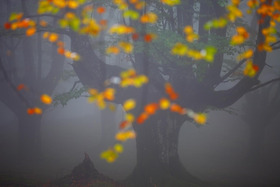
Between seasons
While the rest of the beech forest was still wearing its summer dress, this single branch - obviously being more exposed to the elements - already showed its autumn colours. For a fleeting moment the wet, coloured leaves lit up while the forest in the background drowned in a dense fog.
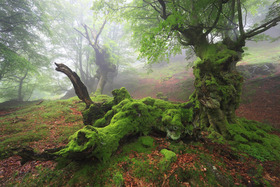
Chinese dragon
And all of a sudden familiar shapes appear where there was nothing to be seen before .... The magic of spring ...
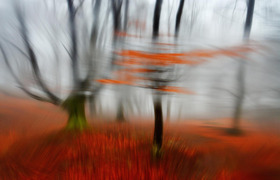
Dancing forest
Winter had already gone and the forest appeared bleak and bare. But a single branch had kept its colourful autumn leaves.
This image was taken towards the end of the day when dusk was settling. To create the effect of the "dancing" trees, I used a polarizer and uv filter, on which I had applied some Vaseline smearing it in different directions.
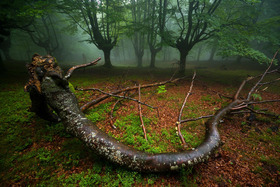
Foetus
I certainly would have liked a different title for the image, but to me, this sight did not allow for any other sensation.
As if its deformed body had fallen all too soon and was now asking its fellow trees for help. This is how I saw it.
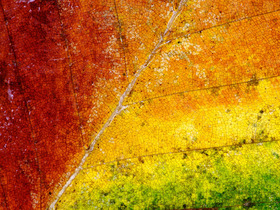
Four seasons
On a rainy day full of atmosphere I was once again strolling through the beech forest. Since the day did not have much to offer for landscape photography, I focussed on details. This is when I noticed this leaf and when I had a closer look, discovered that on a tiny area of only a few square centimetres it echoed the whole seasonal cycle of the beech forest.
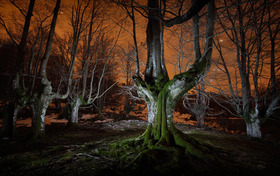
Haunted night
It is said that in former times witches used to gather in places like this one, and on this winter night it seemed as if also the old beech trees were also cooking up something ...
To illuminate the scene I used a flash light that I triggered at different positions with varying intensity. The orange colour of the sky stems from the lights of nearby cities that surround Gorbeia.
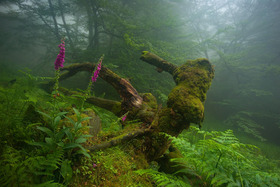
Jewels of the forest
I had been looking for these beautiful flowers for a few days when I suddenly stumbled across them. Conditions could not have been any better: fog drifted through the forest, and all I had to do was wait for the right moment.
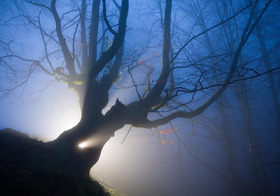
Magical twins
Already a few years ago when I saw this beautiful tree for the first time, I got the idea for an image like this one . The idea developed and grew over time, and I knew, one day I would be presented with just the right conditions to create this image. And so it happened on this particular night, and while I was taking the photograph and triggering the flash, an owl called right next to me. The result was even better than I had hoped for - magical Gorbeia.
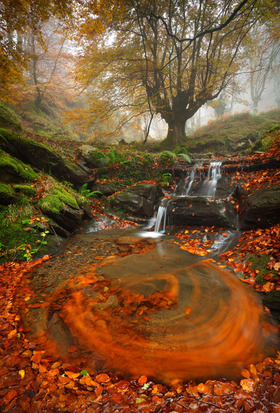
Catching the autumn
In 2012 we finally had a very nice autumn in Gorbeia. This spot had appealed to me already when I discovered it a few weeks ago, but I never imagined how beautifully it would develop. Plenty of fallen leaves, water, a bit of a mist and still enough coloured leaves on the trees - what a wonderful day.
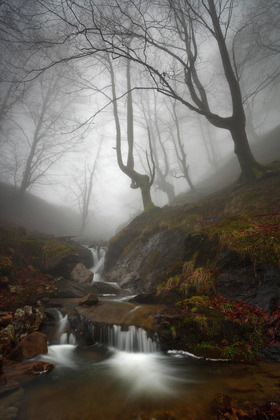
Embrace of the forest
On this cold rainy day in the forest the atmosphere was even more intense than ever. In such moments it is easy to believe that the forest wants you to become a part of it ...
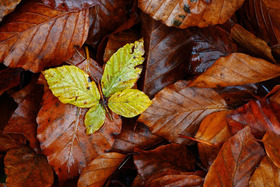
Secrets of the forest
I have always known that this forest is magical, but I never thought I would ever come so close to one of its enchanted creatures ...











